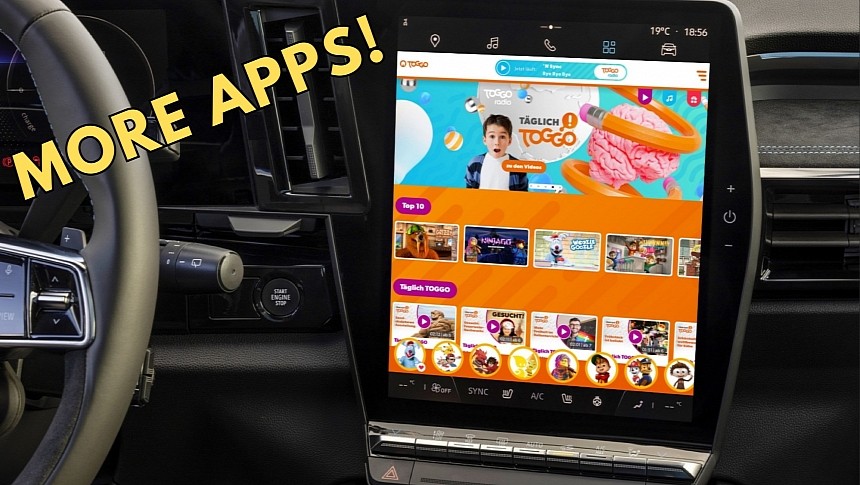The number of Android Automotive apps keeps growing, mainly as Google puts a lot of effort into improving the operating system's adoption.
The search giant is permanently in touch with carmakers, not only to support the existing vehicle integrations of Android Automotive but also to install the OS into new models.
App makers rapidly noticed the opportunity of targeting a new audience, so the Android Automotive app ecosystem keeps expanding with new additions.
German TV channel Super RTL has decided to launch Toggo, its streaming service offering content for children aged 2 to 13, to Android Automotive, allowing car passengers to watch TV shows on the infotainment screen. The content is only available when the vehicle is blocked and is automatically blocked when it starts moving.
Toggo is available in Germany, Austria, and Switzerland, in all cars powered by Android Automotive, including models from Polestar, Volvo, and Renault.
Streaming services in new-generation cars make perfect sense, mainly because they are allowed only when the vehicle is parked. Android Automotive-powered cars typically come with electric motors, so watching TV shows and other video content while waiting to charge the battery is very convenient.
Similar capabilities could theoretically be offered on Android Auto too, but Google so far keeps ignoring the requests in this regard. Streaming services, including Netflix, HBO Max, and YouTube, are banned on Android Auto.
Google could use a similar approach to Android Automotive, allowing these services to play content only when the vehicle is parked. The company already has the means to make it happen, using a mobile device to detect when the car starts moving. A similar concept powers the typing experience on Android Auto, as users are allowed to type an address in Waze only when the car is parked. Once the vehicle starts moving, typing is restricted.
Users have already found alternative ways to enable YouTube in their cars on Android Auto. Sometimes, their methods also allow watching videos when the vehicle is in motion. This approach is a huge no-no, as it could significantly boost distraction, as drivers would be tempted to look at the screen and take their eyes off the road.
For now, Google isn't willing to unlock video streaming services on Android Auto, as Android Automotive has become the first-class citizen of its automotive strategy. I expect more apps to join the AAOS ecosystem in the coming months, especially because Google keeps working with more carmakers to adopt the operating system.
Ford, Honda, and General Motors will install Android Automotive into their future models. General Motors has also decided to block Android Auto and CarPlay in its upcoming electric vehicles, as the company goes all-in on Android Automotive, beginning with the 2024 Blazer EV.
App makers rapidly noticed the opportunity of targeting a new audience, so the Android Automotive app ecosystem keeps expanding with new additions.
German TV channel Super RTL has decided to launch Toggo, its streaming service offering content for children aged 2 to 13, to Android Automotive, allowing car passengers to watch TV shows on the infotainment screen. The content is only available when the vehicle is blocked and is automatically blocked when it starts moving.
Toggo is available in Germany, Austria, and Switzerland, in all cars powered by Android Automotive, including models from Polestar, Volvo, and Renault.
Streaming services in new-generation cars make perfect sense, mainly because they are allowed only when the vehicle is parked. Android Automotive-powered cars typically come with electric motors, so watching TV shows and other video content while waiting to charge the battery is very convenient.
Similar capabilities could theoretically be offered on Android Auto too, but Google so far keeps ignoring the requests in this regard. Streaming services, including Netflix, HBO Max, and YouTube, are banned on Android Auto.
Google could use a similar approach to Android Automotive, allowing these services to play content only when the vehicle is parked. The company already has the means to make it happen, using a mobile device to detect when the car starts moving. A similar concept powers the typing experience on Android Auto, as users are allowed to type an address in Waze only when the car is parked. Once the vehicle starts moving, typing is restricted.
Users have already found alternative ways to enable YouTube in their cars on Android Auto. Sometimes, their methods also allow watching videos when the vehicle is in motion. This approach is a huge no-no, as it could significantly boost distraction, as drivers would be tempted to look at the screen and take their eyes off the road.
For now, Google isn't willing to unlock video streaming services on Android Auto, as Android Automotive has become the first-class citizen of its automotive strategy. I expect more apps to join the AAOS ecosystem in the coming months, especially because Google keeps working with more carmakers to adopt the operating system.
Ford, Honda, and General Motors will install Android Automotive into their future models. General Motors has also decided to block Android Auto and CarPlay in its upcoming electric vehicles, as the company goes all-in on Android Automotive, beginning with the 2024 Blazer EV.










